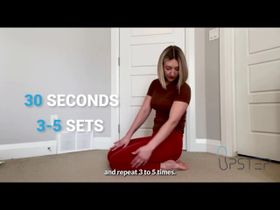Prevent Shin Splints with Compression Socks: Tips and Tricks
Updated October 15, 2024

Are you tired of shin splints sidelining your active lifestyle? You're not alone! They affect up to 35% of all runners, and diagnosing and treating them can be a challenge.
Shin splints, officially known as medial tibial stress syndrome, are common among those engaged in high-impact activities like running or jumping. The condition can worsen if left untreated, potentially leading to stress fractures. But there's good news: compression socks and custom orthotics, like Upstep's, can help manage this condition effectively.
Do Compression Socks Help with Shin Splints?
Compression socks work by applying pressure to the tissues of the lower leg. This compression stimulates blood circulation, reduces swelling, and hence, eases pain. By wearing compression socks during and after your runs, you can support the muscles around the tibia bone, alleviating the stress placed on them. Furthermore, improved blood circulation can lead to faster healing and reduced recovery time, enabling you to return to your activities sooner.
Did you know?
Shin splints can refer to several different problems that cause shin pain, such as compartment syndrome, medial tibial stress syndrome, and tibial stress fracture. These different types of shin splints can often overlap and cause confusion, making diagnosis and treatment challenging.
» Here are some easy foam roller exercises for shin splints
Benefits of Compression Shocks for Shin Splints
If you want to get back to working out as quickly as possible and achieve your full potential, you need to understand how to aid your body's recovery process. Compression socks can be a crucial tool in this journey.
Let's dive into the key benefits they bring to the table:
Pain Relief
By applying pressure to the tissues of the lower leg, compression socks help to improve blood circulation. With improved circulation comes a reduction in inflammation, a key contributor to the pain associated with shin splints. As a result, the healing process can be expedited, leading to faster pain cessation. In the long run, this allows you to maintain your active lifestyle without being hampered by persistent discomfort.
Better Performance
Muscle fatigue is a common setback when engaging in high-impact activities. Compression socks can reduce this fatigue by improving blood supply to the muscles. With increased oxygen and nutrient delivery, your muscles can function more efficiently, potentially enhancing your performance during your runs or workouts.
Quicker Recovery and Reduced Risk of Injury
Post-exercise muscle soreness is largely due to the buildup of lactic acid. Improved blood flow, facilitated by compression socks, aids in the removal of this lactic acid. This not only reduces post-exercise soreness but also speeds up the recovery process. Additionally, wearing compression socks during exercise can reduce the onset of muscle fatigue, leading to less strain on the tissues and ultimately, a lower risk of injury. This means you can get back to your activities sooner and with a greater sense of security.
» Find out what vitamins you should take if you have shin splints
Bonus Support: Custom Orthotics
Custom orthotics provide support to the feet while offering shock-absorbing qualities. They are designed to absorb the shock placed through the tibia bone, take the strain off the tissues in the lower legs, and improve overall foot alignment. Made with high-grade durable materials, these orthotics can reduce the risk of further injury and alleviate the pain associated with shin splints.
Start Your Recovery Journey
Treating shin splints effectively requires a multifaceted approach. Besides rest and traditional treatments, consider incorporating compression socks and custom orthotics into your routine. Remember to consult with a healthcare professional before starting any new treatment regimen for shin splints.








